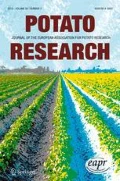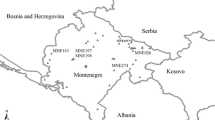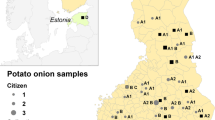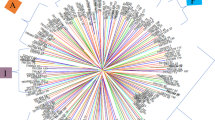Abstract
Chile is the origin of the Solanum tuberosum group Chilotanum corresponding to lowland tetraploid landraces. The most complete morphological description of the Chilean germplasm was published in 2008 in the Catalogue of Varieties of Native Potatoes from Chile, which describes 211 varieties. Two institutions of the Chilean government, INIA and SAG (Agricultural and Livestock Service of Chile), keep collections of 332 and 257 accessions, respectively; the varieties registered in the catalogue are included in the SAG collection. Thus, an important gap occurs between the number of varieties listed in the National Catalogue of Chile and the number of traditional varieties found in the Chilean collections of potatoes. In this work, two national collections of Chilean native germplasms (INIA-Remehue and SAG) were analysed via four microsatellite markers with the aims of (1) discriminating different genotypes in order to more accurately catalogue the current number of native Chilean varieties, (2) evaluating the diversity of genotypes potentially known with the same nomenclature by farmers, and (3) comparing allelic diversity of native germplasm with 44 commercial varieties. Of the 589 native accessions analysed, 320 different allelic phenotypes were found indicating that there are at least 320 different genotypes in the collections. Of these, 158 belonging to the INIA collection were not found in the SAG collection. These 158 new genotypes should increase the number of known Chilean varieties. As expected, different genotypes were known under the same popular name. In terms of allelic diversity, the group of commercial varieties contained a subset of the alleles within the collection of SAG and INIA-Remehue.



Similar content being viewed by others
Abbreviations
- CIP:
-
International Potato Centre
- DNA:
-
Deoxyribonucleic acid
- GBS:
-
Genotyping by sequencing
- INIA:
-
Instituto de Investigaciones Agropecuarias de Chile (Institute of Agricultural Research of Chile)
- PCR:
-
Polymerase chain reaction
- SAG:
-
Servicio Agrícola y Ganadero de Chile (Agricultural and Livestock Service of Chile)
- SSR:
-
Simple sequence repeats
- UPOV:
-
International Union for the Protection of New Varieties in Plants
References
Ames M, Spooner D (2008) DNA from herbarium specimens settles a controversy about origins of the European potato. Am J Bot 95(2):252–257
Anderson JA, Churchill GA, Autrique JE, Tanksley SD, Sorrells ME (1993) Optimizing parental selection for genetic linkage maps. Genome 36(1):181–6
Contreras A, Castro I (2008) Catálogo de variedades de papas nativas de Chile. Universidad Austral de Chile, Chile, p 234
Cubero J (2003) Introducción a la Mejora Genética Vegetal. Ediciones Mundi_Prensa, Madrid España, p 556
De Haan S, Nuñez J, Bonierbale M, Ghislain M, van der Maesen J (2013) A Simple Sequence Repeat (SSR) Marker Comparison of a Large In- and Ex-situ Potato Landrace Cultivar Collection from Peru Reaffirms the Complementary Nature of both Conservation Strategies. Diversity 5:505–521
Fu Y, Peterson G, Richards K, Tam R, Percy J (2009) Genetic diversity of Canadian and exotic potato germplasm revealed by simple sequence repeat markers. Am J Pot Res 86:38–48
Fulton TM, Chunwongse J, Tanksley SD (1995) Microprep protocol for extraction of DNA from tomato and other herbaceous plants. Plant Mol Biol Report 13(3):207–209
Ghislain M, Spooner DM, Rodriguez F, Villamón F, Núñez J, Vásquez C et al (2004) Selection of highly informative and user-friendly microsatellites (SSRs) for genotyping of cultivated potato. Theor Appl Genet 108:881–890
Ghislain M, Núñez J, Herrera M, Pignataro J, Guzman F, Bonierbale M, Spooner D (2009) Robust and highly informative microsatellite-based genetic identity kit for potato. Mol Breeding 23:377–388
Hale A, Miller C, Rengayanaki K, Fritz A, Coombs J, Frank L, Douches S (2005) Suitability of AFLP and microsatellite marker analysis for discriminating intraclonal variants of the potato cultivar Russet Norkotah. J Amer Soc Hort Sci 130(4):624–630
Hawkes JG (1990) The potato: evolution, biodiversity and genetic resources. Belhaven Press, London, p 259
Hawkes JG (1994) Origins of cultivated potatoes and species relationships. In: Bradshaw JE, Mackay GR (eds) Potato genetics. CAB International, Wallingford, pp 3–42
Hosaka K, Hanneman RE (1988) The origin of the cultivated tetraploid potato based on chloroplast DNA. Theor Appl Genet 76:172–176
International Potato Center (CIP) (2008) In: Herrera M d R, Ghishlain M (eds) Potato Genetic Identity (PGI) Kit. Protocols and reference ladders. Applied Biotechnology laboratory training manual, Lima, Perú
Kaminsky KP, Korup K, Andersen MN, Sonderkaer M, Kirk AG, Nielsen KL (2015) Cytosolic glutamine synthetase is important for photosynthetic efficiency and water use efficiency in potato as revealed by high‑throughput sequencing QTL analysis. Theor. Appl. Genet. DOI 10.1007/s00122-015-2573-2
Leberg PL (2002) Estimating allelic richness: effects of sample size and bottlenecks. Mol Ecol 11:2445–2449
Machida-Hirano R (2015) Diversity of potato genetic resources. Breed Sci 65:26–40
Mathias M, Sagrado B, Kalazich J (2007) Uso de Marcadores SSR para Identificación de Germoplasma de Papa en el Programa de Mejoramiento de INIA de Chile. Agric Téc 67(1):3–15
Mendoza H, Mosquera V (2011) Selección de variedades de papa. Héctor Alcántara Santillán, Lima – Perú, p 108
Nei M (1987) Analysis of gene diversity in subdivided populations. Proc Natl Acad Sci U S A 70(12):3321–3323
Ovchinnikova A, Krylova E, Gavrilenko T, Smekalova T, Zhuk M, Knapp S, Spooner D (2011) Taxonomy of cultivated potatoes (Solanum section Petota: Solanaceae). Bot J Linn Soc 165:107–155
Perez J, Riegel R (2004). Evaluación de la diversidad genética de papas nativas Solanum tuberosum L. spp. tuberosum (Hawkes) silvestres y cultivadas del sur de Chile, mediante el uso de marcadores microsatélites. Thesis, Universidad Austral de Chile: Valdivia, Chile, p 68
Perrier X, Jacquemoud-Collet JP (2006) DARwin Software, version 5.0.158. CIRAD, Montpellier, France
Perrier X, Flori A, Bonnot F (2003) Data analysis methods. In: Hamon P, Seguin M, Perrier X, Glaszmann JC (eds) Genetic diversity of cultivated tropical plants. Enfield, Science Publishers, Montpellier, pp 43–76
Reid A, Kerr EM (2007) A rapid simple sequence repeat (SSR)-based identification method for potato cultivars. Plant Genet Resour Characterizat Util 5:7–13
Rios D, Ghislain M, Rodriguez F, Spooner D (2007) What is the origin of the European potato. Evidence from Canary Island Landraces. Crop Sci 47:1271–1280
Rocha E, Paiva L, de Carvalho H, Guimarães C (2010) Molecular characterization and genetic diversity of potato cultivars using SSR and RAPD markers. Crop Breed Appl Biotechnol 10(3):204–210. doi:10.1590/S1984-70332010000300004, Retrieved August 11, 2015, from http://www.scielo.br/scielo.php?script=sci_arttext&pid=S198470332010000300004&lng=en&tlng=en
Rubilar M, Villaroel M, Paillacar M, Moenne Locóz D, Shene C, Biolley E, Acevedo F (2012) Native black Michuñe potato variety: characterization, frying conditions and sensory evaluations. Arch Latinoam Nutr 62(1):87–93
Ruiz de Galareta J, Barandalla L, Lorenzo R, Gonzalez J, Rios D, Ritter E (2007) Microsatellite variation in potato landraces from the island of La Palma. Span J Agric Res 5(2):186–192
SAG, 2015. Servicio Agrícola y Ganadero SAG, registro histórico de variedades oficialmente descritas. http://www.sag.gob.cl/ambitos-de-accion/lista-de-variedades-oficialmente-descritas. Retrieved August 10, 2015.
Solano J, Mathias M, Esnault F, Brabant P (2013) Genetic diversity among native varieties and commercial cultivars of Solanum tuberosum ssp. tuberosum L. present in Chile. Electronic Journal Of Biotechnology, 16(6). Retrieved August 11, 2015, fromhttp://www.ejbiotechnology.info/index.php/ejbiotechnology/article/view/v16n6-15/1791
Spanoghe M, Marique T, Rivière J, Lanterbecq D, Gadenne M (2015) Investigation and Development of Potato Parentage Analysis Methods Using Multiplexed SSR Fingerprinting. 2015. Potato Res 58:43–65
Spooner DM (2009) DNA barcoding will frequently fail in complicated groups: an example in wild potatoes. Amer J Bot 96:1177–1189
Spooner DM, Núñez J, Trujillo G, Del Rosario HM, Guzmán F, Ghislain M (2007) Extensive simple sequence repeat genotyping of potato landraces supports a major reevaluation of their gene pool structure and classification. Proc Natl Acad Sci U S A 104:19398–19403
Uitdewilligen JGAML, Wolters A-MA, D’hoop BB, Borm TJA, Visser RGF, van Eck HJ (2013) A Next-Generation Sequencing Method for Genotyping-bySequencing of Highly Heterozygous Autotetraploid Potato. PLoS One 8(5):e62355. doi:10.1371/journal.pone.0062355
Acknowledgments
This study was funded by the CONICYT PBCT Program PDA09 Fortalecimiento de capacidades regionales en biotecnología para explotar la diversidad del genoma de la papa, Chilean Minister of Agriculture and Project 501453–70 Conservación de Recursos Genéticos.
We greatly acknowledge the Agricultural and Livestock Service (SAG) for kindly providing potato clones from their field collection.
Author information
Authors and Affiliations
Corresponding author
Ethics declarations
Conflict of Interest
The authors declare that they have no conflict of interest.
Rights and permissions
About this article
Cite this article
Muñoz, M., Folch, C., Rodriguez, F. et al. Genotype Number and Allelic Diversity Overview in the National Collection of Chilean Potatoes. Potato Res. 59, 227–240 (2016). https://doi.org/10.1007/s11540-016-9329-5
Received:
Accepted:
Published:
Issue Date:
DOI: https://doi.org/10.1007/s11540-016-9329-5




